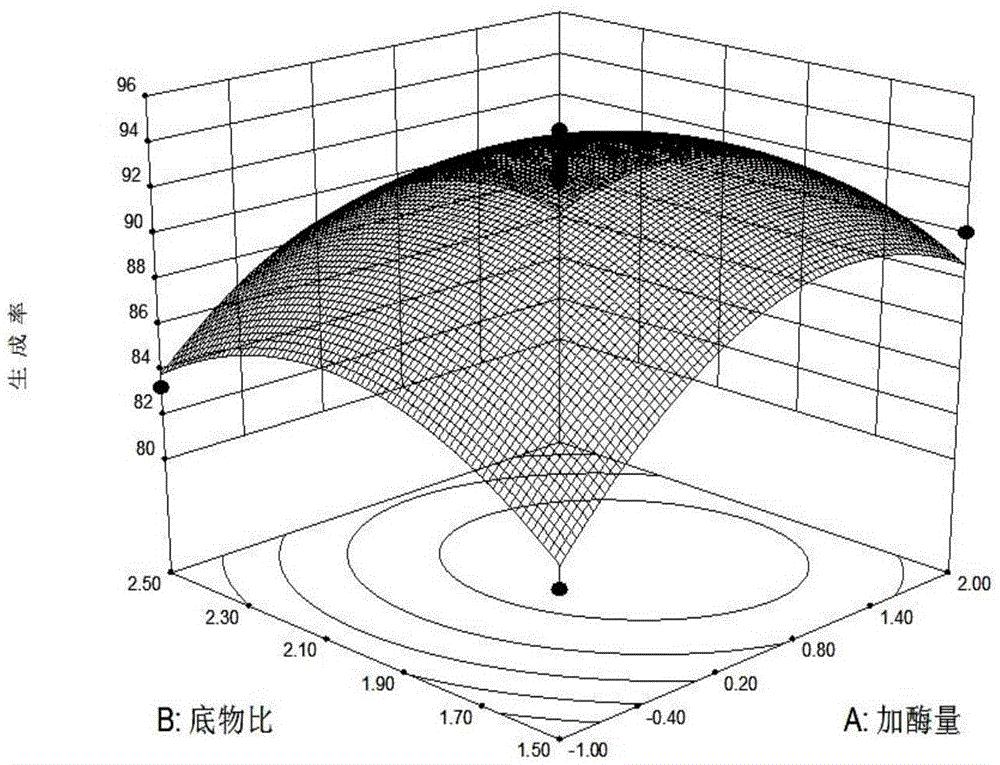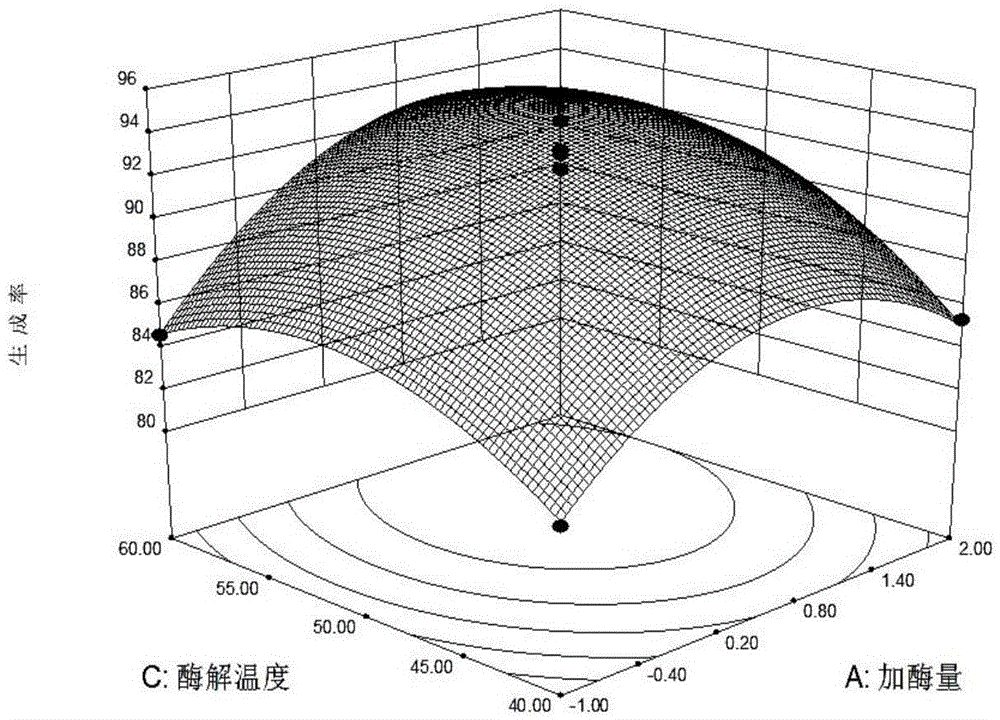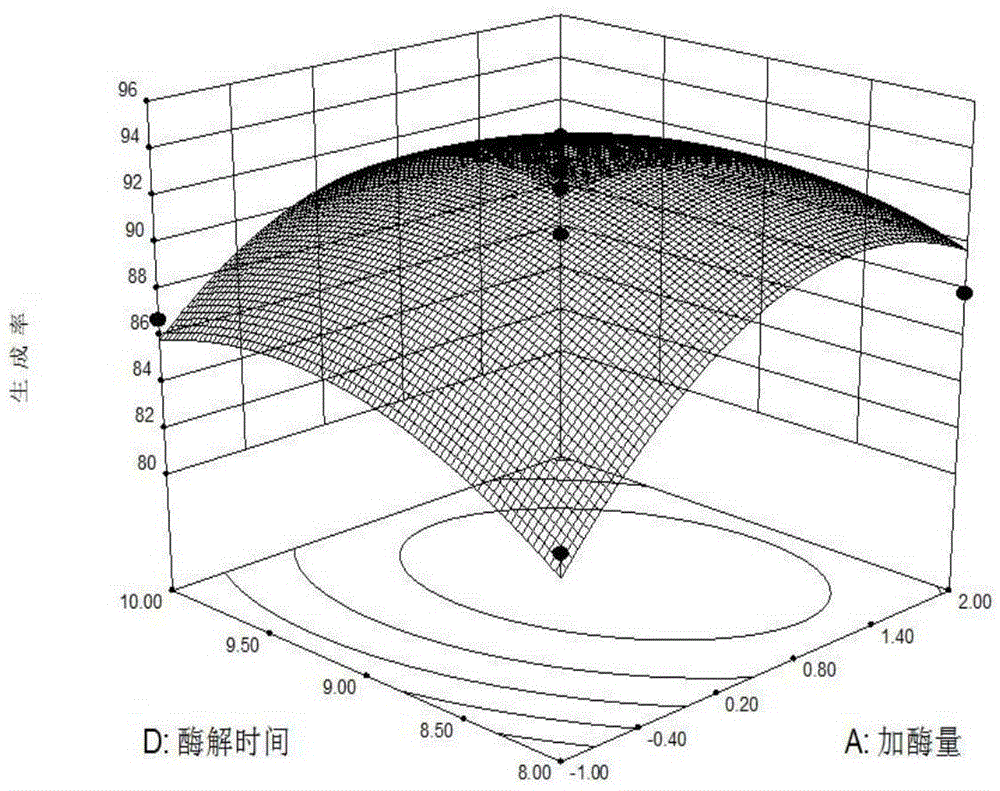Method for preparing duck oil diglyceride
A technology of diglyceride and duck oil, which is applied in the field of immobilized lipase to catalyze the preparation of duck oil diglyceride, can solve the problems of pollution, a large number of chemical reagents, and low product purity, and achieve reduced production costs, reduced environmental pollution, and guaranteed The effect of food safety
- Summary
- Abstract
- Description
- Claims
- Application Information
AI Technical Summary
Problems solved by technology
Method used
Image
Examples
preparation example Construction
[0027] 1) Preparation of mixed fatty acids: put 200g of duck oil into a 1000mL beaker, add distilled water to 440mL, and place in a constant temperature water bath at 87°C for 1.5h. Then transfer to a separatory funnel to remove the lower layer, and repeat the above operation. Then add a certain amount of 1mol / L NaOH solution, hydrolyze at a constant temperature of 87°C, wash with NaCl to remove glycerol, acidify to pH 2-3 with 10% HCl, and release free fatty acids.
[0028] 2) Preparation of duck oil diglycerides: Put glycerol and duck oil mixed fatty acids in a ratio of 1:0.5-3 into an Erlenmeyer flask, add 0.5%-3% of immobilized Candida antarctica lipase B, Then place it on a shaker, set the temperature at 30°C to 70°C, and set the reaction time at 2 to 12 hours. After the reaction, centrifuge the above reaction solution in a high-speed centrifuge at 4000r / min for 20 minutes to separate the enzyme. The obtained supernatant is a high-purity diglyceride mixture. The content...
Embodiment 1
[0030] Embodiment 1: the preparation of duck oil diglyceride
[0031] Put glycerin and duck oil mixed fatty acid into the Erlenmeyer flask according to the ratio of 1:0.5-3, add 0.5%-3% immobilized Candida antarctica lipase B, then place it on the shaker, set the temperature as 30 ℃ ~ 70 ℃, set the reaction time to 2 ~ 12h, after the reaction, centrifuge the above reaction solution in a 4000r / min high-speed centrifuge for 20min, then the enzyme can be separated, and the obtained supernatant is high-purity glycerol Diester mixture. The content of the obtained diglyceride mixture was determined by high performance liquid chromatography.
[0032] The optimization steps of above-mentioned reaction conditions are as follows:
[0033] (1) Screening of the amount of enzyme added: the substrate ratio (glycerol: mixed fatty acid) was set to 1:2, the reaction temperature was 50°C, the reaction time was 10h, and the amount of enzyme added was 0.5%, 1%, and 1.5%, respectively, 2%, 2.5%...
Embodiment 2
[0051] Example 2: Enzymatic hydrolysis of duck oil to prepare diglyceride optimal process conditions screening regression test
[0052] Put the mixed fatty acid and glycerol into the Erlenmeyer flask according to the ratio of substrate ratio (glycerol: mixed fatty acid) 1:2.02, place it in a constant temperature shaker, and set the reaction temperature at 44°C, and add 1.65% immobilized Antarctica Trichoceria lipase B, the reaction time is 9.1h. After the reaction, centrifuge the enzymatic solution in a high-speed centrifuge for 10 minutes to separate the enzyme. The supernatant is a mixture of high diglycerides, and the middle layer is immobilized lipase , Determination of the formation rate of diglycerides by liquid chromatography.
[0053] Through 5 verification tests, it was found that the production rate of diglyceride obtained under this condition was 93.25%, 94.09%, 93.88%, 94.22%, 94.17%, and the average extraction rate was 93.92%, which was basically consistent with t...
PUM
 Login to View More
Login to View More Abstract
Description
Claims
Application Information
 Login to View More
Login to View More - R&D
- Intellectual Property
- Life Sciences
- Materials
- Tech Scout
- Unparalleled Data Quality
- Higher Quality Content
- 60% Fewer Hallucinations
Browse by: Latest US Patents, China's latest patents, Technical Efficacy Thesaurus, Application Domain, Technology Topic, Popular Technical Reports.
© 2025 PatSnap. All rights reserved.Legal|Privacy policy|Modern Slavery Act Transparency Statement|Sitemap|About US| Contact US: help@patsnap.com



